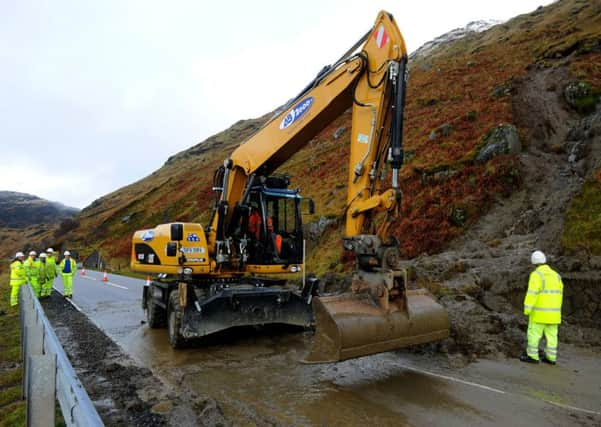True cost of landslides prompts rethink


The study also revealed that 152 roads are prone to landslips – one-third of the Scottish network.
Scientists said the finding could help prioritise spending on protection work.
Advertisement
Hide AdAdvertisement
Hide AdThe study also revealed the most economically vulnerable routes – where a landslip would cause the greatest impact.
These were topped by a stretch of the so-called A830 Road to the Isles between Fort William and Glenfinnan.
A 100-tonne debris landslip closed another part of the road at Lochailort in December.
Next was the A9 between Dalwhinnie and Calvine, followed by the A90 at Cramond Brig over the River Almond in Edinburgh. The other top ranked roads were stretches of the A82 between Corran and Fort William, Achallader (near Bridge of Orchy) and Glencoe, and Fort William and Inverlochy.
Ben Postance, of Loughborough University, said the study showed the economic cost of a landslip blocking the A83 at the Rest and Be Thankful pass for nearly two weeks in 2007 had been around £1.2 million – a similar amount to the repair bill. It was also 60 per cent more than previous estimates.
Postance said: “Disruption costs are not routinely considered in hazard risk management or cost-benefit analysis of safeguards.
“As a consequence there may be sections of the road network that are susceptible to disruption by a landslide hazard, yet which are not prioritised for safeguard measures due to a lack of understanding of the impacts that disruption would cause.”
The IAM RoadSmart Motoring group said the “very valuable” study, published in the Environmental Research Letters journal, made the case for spending more money on averting disruption.
Advertisement
Hide AdAdvertisement
Hide AdNeil Greig, its Scotland-based policy and research director, said: “It suggests significant road upgrades and landslide protection work deliver even greater value for money than previously might have been calculated.
“Against this background, politicians must fund [Scottish Government agency] Transport Scotland properly to allow it to accelerate its programmes and minimise the serious economic disruption that blockages can cause.
“Road travel in the Highlands is an essential lifeline, not a luxury, and a reliable network should be available in all but the most extreme of circumstances.”
A spokeswoman for Transport Scotland, which is responsible for trunk roads, said: “We recognise the risk landslides can pose to the trunk road network and we have operated a risk assessment system since 2010.
“Almost £10m has been invested in landslide mitigation works over the past five years across the network. This includes innovative works on the A83, including at the Rest and Be Thankful, where a further £3m of further works are planned by April 2019.
“We are working with the Transport Research Laboratory to better understand the economic impacts of landslides and how we can further improve our management of the risk.
“We will also review the findings of this research to establish if further lessons can be learned.”
The Dumfries-based National Centre for Resilience, which was opened last year by the Scottish Government, is working on new landslide warnings.
Advertisement
Hide AdAdvertisement
Hide AdA spokeswoman said: “The centre provides access to the latest science on the vulnerability of our transport networks to landslides, to minimise the impact.
“It has contributed to the identification of triggering conditions to aid the development of a landslide early warning system for Scotland.”